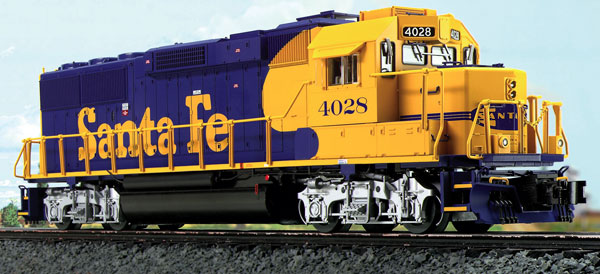Then I took the Atlas O model out of the box and said out loud, “Holy smokes, this model is stunning!” Once again, Atlas O has offered another model that has exceeded expectations.
In real-world railroading, the GP60 was a modern answer to 1930s steamers assigned to crack express and freight runs. The Santa Fe, with its noted history for running fast intermodal trains, turned to General Motors for a reliable four-motor diesel for high-speed freight operations in 1988.
The GP60 displaced the GP50 in the GM catalog. It featured a new, 3,950-horsepower prime mover, improved traction motors, and three microprocessors to manage locomotive operations.
With the exception of a few teething problems, the GP60-series diesels were a solid success on the Santa Fe. Indeed, two variations were spawned: the GP60M (with an improved safety cab design) and GP60B (a cabless unit).
The merger of the Santa Fe and the Burlington Northern didn’t initially affect the mission of the GP60s.
However, when the BNSF ordered more than 1,000 General Electric Dash 9-44s, and standardized on that model, the railroad gradually bumped its GP60s to less glamorous duties.
The model
Atlas O has created a 14-inch-long locomotive that is a work of art.
The front pilot on this scale-sized locomotive features eight add-on multiple-unit control leads, and there’s a brake line on the coupler. Up front you’ll also find a snowplow, two grab irons, and a simulated uncoupler arm.
The front deck has two ditch lights (they blink alternately when the horn is sounded) and a safety chain, and there are two additional headlights on the locomotive’s snout.
The locomotive’s deck features a safety-tread pattern, and there are cast-in latch and hinge details to simulate floor plates that can be opened for access.
The cab includes detailed wiper arms over the windshield, illuminated number boards, and sunshades over the side windows. The Santa Fe units did not have headlights on the cab roof (see the prototype photo on page 91), so, in keeping with Atlas O’s drive for realism, the model has a cast-in metal plate and four bolts covering the light housing. The roof has an air conditioner and a grab iron.
The carbody has all the cast-in latch, hinge, and seam detail we’ve come to expect. The air filters are all solid cast, but the mid-shell blisters are see-through. Rooftop screens are also see-through, with visible 10-bladed fans within. The locomotive trucks are beautiful. If you pick up the model by the trucks, be careful you don’t bend the fine sand lines.
Paint and decoration are superb. Application of the Santa Fe’s blue-and-yellow scheme is excellent, especially over cast-in body features, such as air filters. All separation lines are clean and crisp, with the nomenclature and warning labels well done.
In addition to Santa Fe, Atlas O offers its GP60 in Rio Grande, Cotton Belt, Norfolk Southern, Vermont Railway, and EMD demonstrator colors (the last two as special editions).
Atlas O offers wide-cab and “B unit” GP60 versions in silver-and-red Santa Fe colors and two different BNSF paint schemes. Dummy units and two-rail versions also are available. Check Atlas O’s website (atlaso.com) for specifics and prices.
On the test track
Our sample GP60 delivered fine performance pulling either heavy or light freight trains. On the test track, our conventional-mode, low-speed average was 18 scale mph, while the high-speed average was 80 scale mph. Drawbar pull was a fantastic 3 pounds, 1 ounce.
In TrainMaster Command Control mode, the low-speed average was 3.4 scale mph.
All TMCC functions worked as expected, as did the locomotive’s robust smoke unit and speed-control circuitry.
As usual, the Lionel RailSounds system was great, and locomotive speed was responsive and consistent.
In my book, the Atlas O GP60 is a winner!














